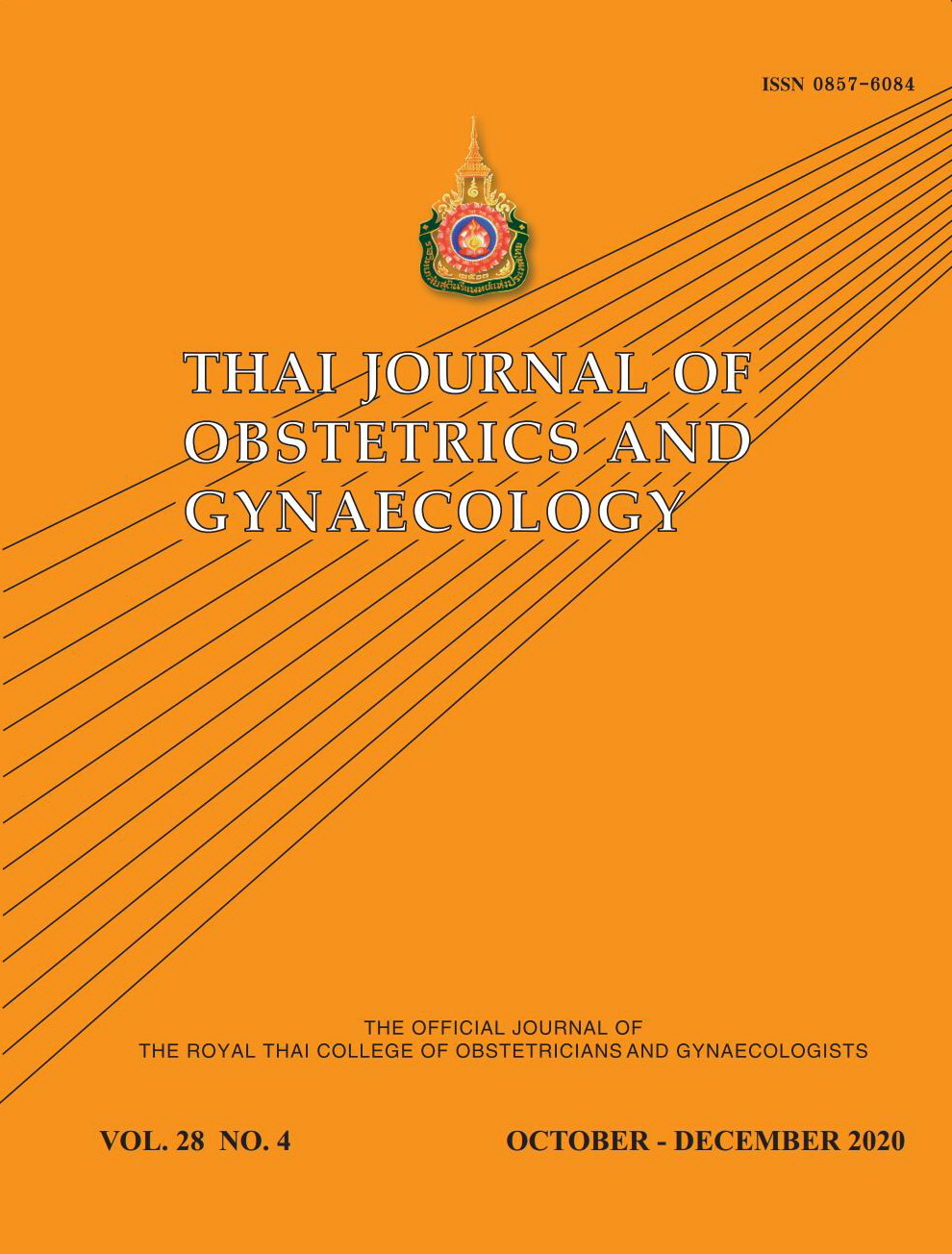The Use of the Infant Breastfeeding Assessment Tool among High Risk Mothers for the Prediction of Exclusive Breastfeeding for Six Weeks Postpartum
Main Article Content
Abstract
Objective: To find the cut-off point, sensitivity and specificity of the infant breastfeeding assessment tool to predict breastfeeding among high risk mother during six weeks postpartum.
Materials and Methods: The infant breastfeeding assessment tool was translated to Thai and the validity and reliability was evaluated. Postpartum mothers who delivered at the HRH Princess Maha Chakri Sririndhorn medical center in the Nakhon Nayok province during the period of July 2014 to June 2015 and had high risk for early breastfeeding cessation were included in this study. The mothers and babies were assessed by the infant breastfeeding assessment tool at 16-24 hours postpartum. Following discharge; the exclusive breastfeeding data at the first, second and sixth weeks postpartum was collected by telephone follow-up. The cut-off point, sensitivity and specificity of the infant breastfeeding assessment tool used for exclusive breastfeeding predictions were calculated by the ROC curve.
Results: Three hundred and sixty-one high risk mothers for early breastfeeding cessation; teenage mothers, mothers with cesarean deliveries and obese mothers were recruited in this study. The validity of the infant breastfeeding assessment tool was 93.2%. The Cronbach alpha coefficient was 82.7. The cut-off point to predict exclusive breastfeeding at the first, second and sixth weeks postpartum was determined to be 8 points. The sensitivity and specificity of tests for the first, second and sixth week exclusive breastfeeding predictions were 88.9, 90.5% and 72.0, 74.6%, respectively. The best prediction accuracy was 73.0 percent at the first week postpartum. The relative risks for early breastfeeding cessation between the mothers and babies who had the infant breastfeeding assessment tool scores of less than and greater than 8 points were 1.7 and 2.1, respectively.
Conclusion: The infant breastfeeding assessment tool can be used for the prediction of exclusive breastfeeding during the first six weeks postpartum. The accuracy of the test was best at the first week postpartum.
Article Details
References
Furman L, Minich NM. Evaluation of breastfeeding of very low birth weight infants: can we use the infant breastfeeding assessment tool? J Hum Lact 2006;22: 175-81.
Altuntas N, Turkyilmaz C, Yildiz H, et al. Validity and reliability of the infant breastfeeding assessment tool, the mother baby assessment tool, and the LATCH scoring system. Breastfeed Med 2014;9:191-5.
Schlomer JA, Kemmerer J, Twiss JJ. Evaluating the association of two breastfeeding assessment tools with breastfeeding problems and breastfeeding satisfaction. J Hum Lact 1999;15:35-9.
Buryk M, Bloom D, Shope T. Efficacy of neonatal release of ankyloglossia: a randomized trial. Pediatrics 2011;128:280-8.
Matthews MK. Developing an instrument to assess infant breastfeeding behaviour in the early neonatal period. Midwifery 1988;4:154-65.
Scott JA, Landers MC, Hughes RM, Binns CW. Factors associated with breastfeeding at discharge and duration of breastfeeding. J Paediatr Child Health 2001;37: 254-61.
Hill PD, Johnson TS. Assessment of Breastfeeding and Infant Growth. Journal of Midwifery & Women’s Health 2007;52:571-8.
Perez-Rios N, Ramos-Valencia G, Ortiz AP. Cesarean delivery as a barrier for breastfeeding initiation: the Puerto Rican experience. J Hum Lact 2008;24: 293-302.
Chaves RG, Lamounier JA, Cesar CC. Factors associated with duration of breastfeeding. J Pediatr (Rio J) 2007;83:241-6.
Thompson LA, Zhang SY, Black E, et al. The Association of Maternal Pre-pregnancy Body Mass Index with Breastfeeding Initiation. Matern Child Hlth J 2013;17: 1842-51.
Zhu P, Hao J, Jiang X, Huang K, Tao F. New insight into onset of lactation: mediating the negative effect of multiple perinatal biopsychosocial stress on breastfeeding duration. Breastfeed Med 2013;8:151-8.
Puapornpong P, Raungrongmorakot K, Paritakul P, Ketsuwan S, Wongin S. Nipple length and its relation to success in breastfeeding. J Med Assoc Thai 2013;96 Suppl 1:S1-4.
Hajian-Tilaki K. Sample size estimation in diagnostic test studies of biomedical informatics. J Biomed Inform 2014;48:193-204.
Phadungkiatwattana P, Tongsakul N. Analyzing the impact of private service on the cesarean section rate in public hospital Thailand. Arch Gynecol Obstet 2011;284:1375-9.
Kumar SP, Mooney R, Wieser LJ, Havstad S. The LATCH scoring system and prediction of breastfeeding duration. J Hum Lact 2006;22:391-7.


